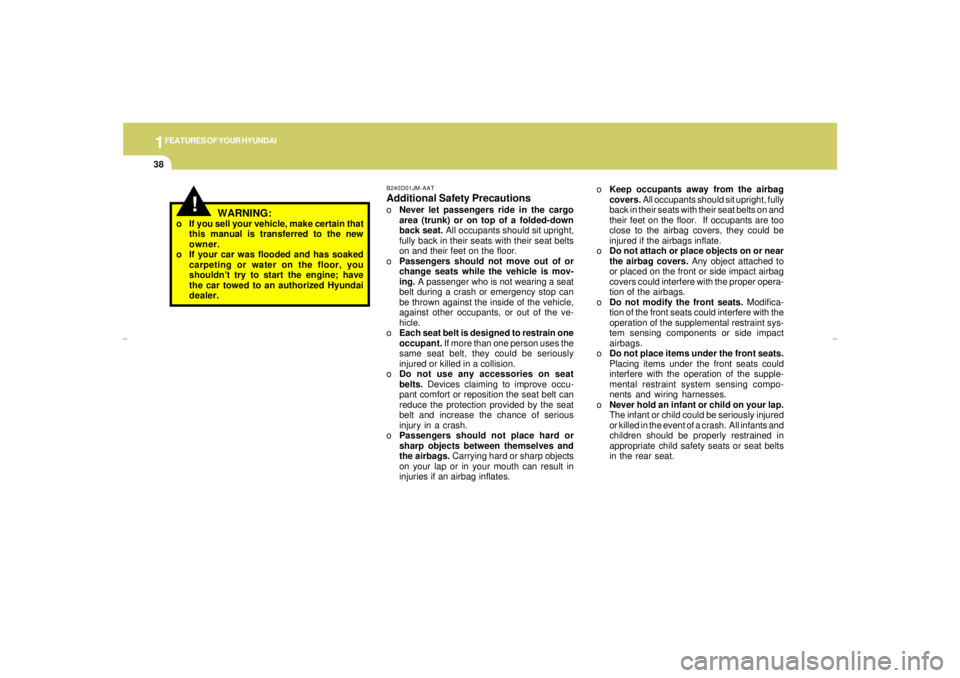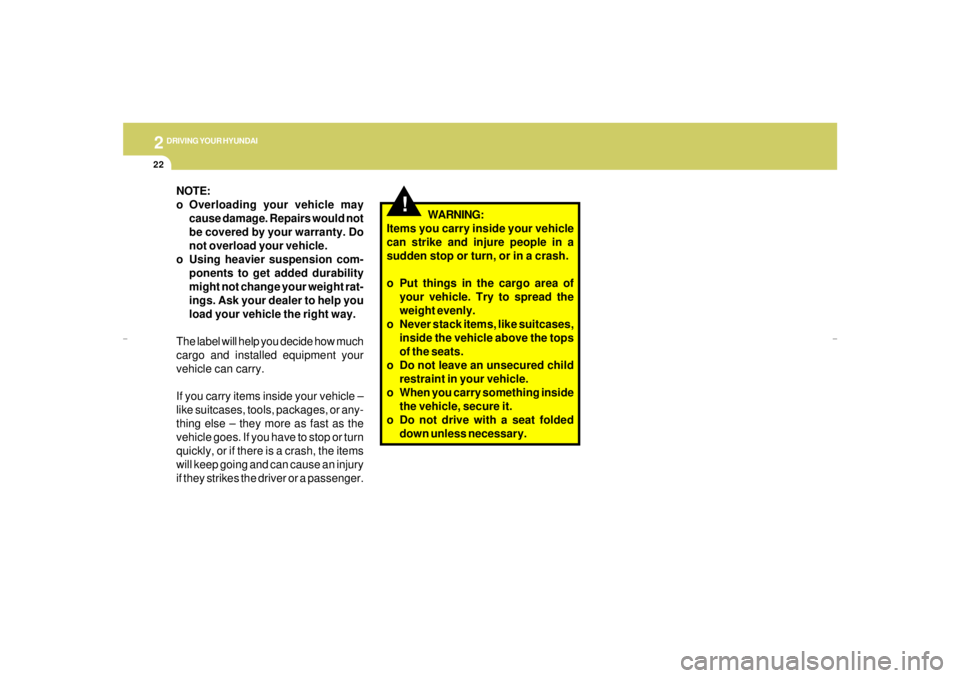2005 HYUNDAI XG350 seats
[x] Cancel search: seatsPage 50 of 247

1FEATURES OF YOUR HYUNDAI38
!
WARNING:
o If you sell your vehicle, make certain that
this manual is transferred to the new
owner.
o If your car was flooded and has soaked
carpeting or water on the floor, you
shouldn't try to start the engine; have
the car towed to an authorized Hyundai
dealer.
B240D01JM-AATAdditional Safety PrecautionsoNever let passengers ride in the cargo
area (trunk) or on top of a folded-down
back seat. All occupants should sit upright,
fully back in their seats with their seat belts
on and their feet on the floor.
oPassengers should not move out of or
change seats while the vehicle is mov-
ing. A passenger who is not wearing a seat
belt during a crash or emergency stop can
be thrown against the inside of the vehicle,
against other occupants, or out of the ve-
hicle.
oEach seat belt is designed to restrain one
occupant. If more than one person uses the
same seat belt, they could be seriously
injured or killed in a collision.
oDo not use any accessories on seat
belts. Devices claiming to improve occu-
pant comfort or reposition the seat belt can
reduce the protection provided by the seat
belt and increase the chance of serious
injury in a crash.
oPassengers should not place hard or
sharp objects between themselves and
the airbags. Carrying hard or sharp objects
on your lap or in your mouth can result in
injuries if an airbag inflates.oKeep occupants away from the airbag
covers. All occupants should sit upright, fully
back in their seats with their seat belts on and
their feet on the floor. If occupants are too
close to the airbag covers, they could be
injured if the airbags inflate.
oDo not attach or place objects on or near
the airbag covers. Any object attached to
or placed on the front or side impact airbag
covers could interfere with the proper opera-
tion of the airbags.
oDo not modify the front seats. Modifica-
tion of the front seats could interfere with the
operation of the supplemental restraint sys-
tem sensing components or side impact
airbags.
oDo not place items under the front seats.
Placing items under the front seats could
interfere with the operation of the supple-
mental restraint system sensing compo-
nents and wiring harnesses.
oNever hold an infant or child on your lap.
The infant or child could be seriously injured
or killed in the event of a crash. All infants and
children should be properly restrained in
appropriate child safety seats or seat belts
in the rear seat.
xgflhma-1.p656/16/04, 3:02 PM 38
Page 152 of 247

2
DRIVING YOUR HYUNDAI
22
!
NOTE:
o Overloading your vehicle may
cause damage. Repairs would not
be covered by your warranty. Do
not overload your vehicle.
o Using heavier suspension com-
ponents to get added durability
might not change your weight rat-
ings. Ask your dealer to help you
load your vehicle the right way.
The label will help you decide how much
cargo and installed equipment your
vehicle can carry.
If you carry items inside your vehicle –
like suitcases, tools, packages, or any-
thing else – they more as fast as the
vehicle goes. If you have to stop or turn
quickly, or if there is a crash, the items
will keep going and can cause an injury
if they strikes the driver or a passenger.WARNING:
Items you carry inside your vehicle
can strike and injure people in a
sudden stop or turn, or in a crash.
o Put things in the cargo area of
your vehicle. Try to spread the
weight evenly.
o Never stack items, like suitcases,
inside the vehicle above the tops
of the seats.
o Do not leave an unsecured child
restraint in your vehicle.
o When you carry something inside
the vehicle, secure it.
o Do not drive with a seat folded
down unless necessary.
xgflhma-2.p656/16/04, 3:00 PM 22
Page 227 of 247

8
CONSUMER INFORMATION & REPORTING SAFETY DEFECTS
7
o Four numbers represent the week
and year the tire was built. For
example, the numbers 3105 means
the 31st week of 2005.
4. Tire ply composition and material
The number of layers or plies of
rubbercoated fabric in the tire. Tire
manufacturers also must indicate
the materials in the tire, which in-
clude steel, nylon, polyester, and
others. The letter "R" means radial
ply construction; the letter "D" means
diagonal or bias ply construction;
and the letter "B" means belted-bias
ply construction.
5. Maximum permissible inflation
pressure
This number is the greatest amount
of air pressure that should be put in
the tire. Do not exceed the maximum
permissible inflation pressure. Refer
to the Tire and Loading Information
label for recommended inflation pres-
sure.6. Maximum load rating
This number indicates the maximum
load in kilograms and pounds that
can be carried by the tire. When
replacing the tires on the vehicle,
always use a tire that has the same
load rating as the factory installed
tire.
7. Uniform Tire Quality Grading
(UTQG):
Tire manufacturers are required to
grade tires based on three perfor-
mance factors: treadwear, traction
and temperature resistance. For more
information, see Uniform Tire Qual-
ity Grading on page 8-14.
I030D01JM-AATTIRE TERMINOLOGY AND DEFINI-
TIONS
Air Pressure: The amount of air inside
the tire pressing outward on the tire. Air
pressure is expressed in pounds per
square inch (psi) or kilopascal (kPa).
Accessory Weight: This means the
combined weight of optional accesso-
ries. Some examples of optional ac-
cessories are, automatic transmission,
power seats, and air conditioning.
Aspect Ratio: The relationship of a
tire's height to its width.
Belt: A rubber coated layer of cords that
is located between the plies and the
tread. Cords may be made from steel or
other reinforcing materials.
Bead: The tire bead contains steel
wires wrapped by steel cords that hold
the tire onto the rim.
Bias Ply Tire: A pneumatic tire in which
the plies are laid at alternate angles
less than 90 degrees to the centerline of
the tread.
xgflhma-8.p656/16/04, 2:57 PM 7
Page 243 of 247

10
INDEX
3
D
Defrosting / Defogging......................................................................1-83
Door
Door locks ...................................................................................... 1-4
Door courtesy light .......................................................................1-74
Locking and unlocking front doors with a key............................... 1-5
Drink Holder......................................................................................1-54
Drive Belts............................................................................... 6-14, 6-17
Driving
Smooth cornering .........................................................................2-12
Winter driving...............................................................................2-13
E
Emission Control System.......................................................... 7-1 ~ 7-4
Engine
Before starting the engine .............................................................. 2-3
Compartment................................................................................. 6-2
Coolant.................................................................................. 6-6 ~ 6-7
Coolant temperature gauge .........................................................1-44
If the engine overheats................................................................. 3-4
Number.......................................................................................... 8-3
Oil .................................................................................................. 6-4
Starting........................................................................................... 2-4
Engine Exhaust Can Be Dangerous................................................... 2-2F
Fan Speed Control ............................................................................1-79
Fog Light
Front.............................................................................................1-45
Front Seats
Adjustable front seats..................................................................1-10
Adjustable headrests ...................................................................1-11
Adjusting seat forward and rearward ..................................1-10, 1-13
Adjusting seatback angle.................................................... 1-11, 1-14
Lumbar support control ................................................................1-12
Seat cushion height adjustment.......................................... 1-12, 1-13
Seat warmer ................................................................................1-16
Fuel
Capacity......................................................................................... 9-2
Gauge..........................................................................................1-43
Recommendations......................................................................... 1-2
Fuel Filler Lid
Remote release .................................................................1-68 ~ 1-69
Manual.........................................................................................1-69
Fuses ..................................................................................... 6-17 ~ 6-18
G
General Checks.................................................................................. 6-3
Glove Box.........................................................................................1-60
xgflhma-10.p656/16/04, 3:01 PM 3